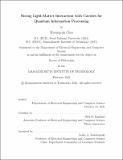| dc.description.abstract | Strong light-matter interaction enabled many modern technologies such as precision metrology, light sources, optical communication and spectroscopy. Normally, the coupling between materials and photons in free-space is weak, limiting the performance of these applications. Photonic cavities can boost this interaction by holding and confining photons in a small space. On the other hand, quantum information science demands extremely strong light-matter interaction. Qubits, the smallest unit of quantum information, needs to be isolated from the environment to preserve its fragile superposition state. Often, single-photons mediate the interaction between distant isolated qubits due to their low loss. Because it is only a single photon and single qubit, the interaction is naturally very weak and needs to be enhanced using photonic cavities.
We propose two methods for enhancing light-matter interaction. In the first method, we focus on "electric" light-matter interaction in a dielectric cavity. We engineer electromagnetic boundary conditions to locally increase the electric energy density. We illustrate the design concept with a silicon nanobeam photonic crystal cavity reaching ultrasmall mode volume that is a hundred-thousand-times smaller than the diffraction limit. In the second method, we study "magnetic" light-matter interaction in a metallic cavity. The three mode engineering techniques presented entail existing cavity designs and show how to further increase the interaction. Especially, in both cases, we show that the mode volume can be arbitrarily small, only limited by materials or fabrication methods. The ultrastrong light-matter interaction opens the door to quantum network, quantum internet, and quantum computing. | |
